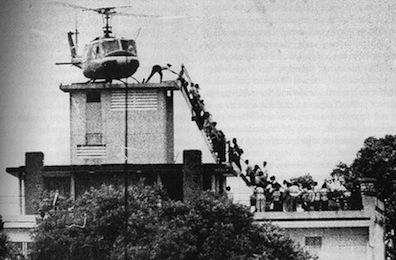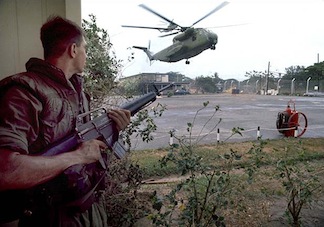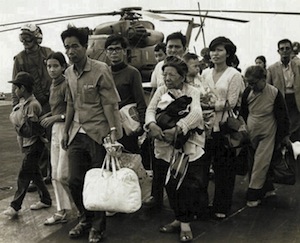Summary | Excerpt | Reviews | Beyond the Book | Read-Alikes | Genres & Themes | Author Bio

Critics' Opinion:
Readers' Opinion:
First Published:
Apr 2015, 384 pages
Paperback:
Apr 2016, 384 pages
 Book Reviewed by:
Book Reviewed by:
Poornima Apte
Buy This Book
This article relates to The Sympathizer
 Viet Thanh Nguyen's debut The Sympathizer vividly describes the fall of Saigon (now Ho Chi Minh City) in the opening chapters as the narrator is transported out of the city along with a host of fellow citizens who have served the American cause in some way.
Viet Thanh Nguyen's debut The Sympathizer vividly describes the fall of Saigon (now Ho Chi Minh City) in the opening chapters as the narrator is transported out of the city along with a host of fellow citizens who have served the American cause in some way.
April 30, 2015 marked the fortieth anniversary of the fall of Saigon. Theoretically, the Vietnam war ended in 1973 with the signing of the Paris Peace Accords and the withdrawal of large-scale American troops. Nevertheless a skeletal force of U.S. Marines and military officers were retained to maintain U.S. consul offices in a few key South Vietnam cities including Saigon. A new Defense Attache's Office (DAO) was created to keep an eye on the geopolitical situation and to fund arms for the South Vietnamese army, the Army of the Republic of Vietnam. It was generally assumed that with a precarious peace holding, any incursions by the North Vietnamese would be met with sustained resistance from the South, backed by financial support from the United States. But with President Nixon's resignation and unstable oil prices, American enthusiasm for continued presence in Vietnam started to rapidly wane and, with it, so did the financial backing.
 It is under this strained climate that the North Vietnamese started making major incursions into the South in late 1974 and early 1975. Successful in the northern parts of South Vietnam, the People's Army of North Vietnam systematically took the major cities of Hue and Da Nang in late March of 1975. Concerned about the stability of Saigon, President Ford called for evacuation of American personnel and South Vietnamese refugees. Worried that a sudden withdrawal would lead to large-scale panic and loss of many lives at the hands of the North Vietnamese, the evacuation was to be gradual.
It is under this strained climate that the North Vietnamese started making major incursions into the South in late 1974 and early 1975. Successful in the northern parts of South Vietnam, the People's Army of North Vietnam systematically took the major cities of Hue and Da Nang in late March of 1975. Concerned about the stability of Saigon, President Ford called for evacuation of American personnel and South Vietnamese refugees. Worried that a sudden withdrawal would lead to large-scale panic and loss of many lives at the hands of the North Vietnamese, the evacuation was to be gradual.
The last straw that completely buckled South Vietnamese defenses came on April 21 with the fall of Xuan Loc, a town just northeast of Saigon. With its fall, President Nguyen Van Thieu saw the writing on the wall and resigned blaming the Americans for letting an ally down.
 By April 27, the North Vietnamese army had circled Saigon. The runways at Tan Son Nhat Air Base (which had been the location for most evacuations up that point) had been destroyed, so a hastily implemented Plan B was initiated. Fixed-wing airplanes were abandoned in favor of large helicopters which departed, not just from the airport, but also from city rooftops to carry evacuees to American ships stationed in the South China Sea. More than 7,000 were evacuated on April 29-30, 4,300 from the Defense Attache's Office alone.
By April 27, the North Vietnamese army had circled Saigon. The runways at Tan Son Nhat Air Base (which had been the location for most evacuations up that point) had been destroyed, so a hastily implemented Plan B was initiated. Fixed-wing airplanes were abandoned in favor of large helicopters which departed, not just from the airport, but also from city rooftops to carry evacuees to American ships stationed in the South China Sea. More than 7,000 were evacuated on April 29-30, 4,300 from the Defense Attache's Office alone.
The last of the American helicopters left from the DAO office in the airport compound on April 30, but days after American ships continued to receive refugees who either somehow swam out to them, or were transported by the South Vietnamese army. In addition to American personnel, almost 140,000 Vietnamese were evacuated (or self-evacuated) and were processed as refugees to enter the United States.
Fearing American intervention in their plans to take over the South, the North Vietnamese army did not attack the departing helicopters, and their tanks plowed through the gates of the Independence Palace on April 30, effectively dissolving the South Vietnamese government.
The images of American helicopters leaving Saigon have become iconic. Perhaps none is more so than the one shot by Dutch photographer Hubert Van Es showing evacuees being airlifted from the rooftop of an apartment building where senior CIA officials were housed (first picture above). An absorbing op-ed by Van Es in The New York Times describing history unfolding before his very eyes as he took that famous picture, is a must-read.
Rory Kennedy, daughter of Senator Robert Kennedy, produced a riveting documentary, Last Days In Vietnam, which won the 2014 Academy Award for best documentary feature. The evacuations come to life even in vivid detail. Click link below to watch a trailer.
Hubert Van Es photograph of helicopter leaving Saigon, courtesy of Targaryen
A marine provides security as a helicopter lands at the DAO compound, courtesy of Ras67
South Vietnamese refugees arrive on a U.S. Navy vessel during Operation Frequent Wind, courtesy of Jbarta
Filed under People, Eras & Events
![]() This "beyond the book article" relates to The Sympathizer. It originally ran in April 2015 and has been updated for the
April 2016 paperback edition.
Go to magazine.
This "beyond the book article" relates to The Sympathizer. It originally ran in April 2015 and has been updated for the
April 2016 paperback edition.
Go to magazine.





The Flower Sisters
by Michelle Collins Anderson
From the new Fannie Flagg of the Ozarks, a richly-woven story of family, forgiveness, and reinvention.

The House on Biscayne Bay
by Chanel Cleeton
As death stalks a gothic mansion in Miami, the lives of two women intertwine as the past and present collide.

The Funeral Cryer by Wenyan Lu
Debut novelist Wenyan Lu brings us this witty yet profound story about one woman's midlife reawakening in contemporary rural China.
Your guide toexceptional books
BookBrowse seeks out and recommends the best in contemporary fiction and nonfiction—books that not only engage and entertain but also deepen our understanding of ourselves and the world around us.